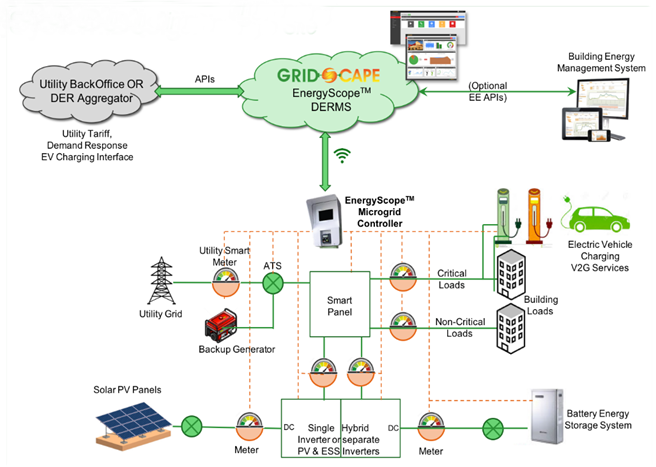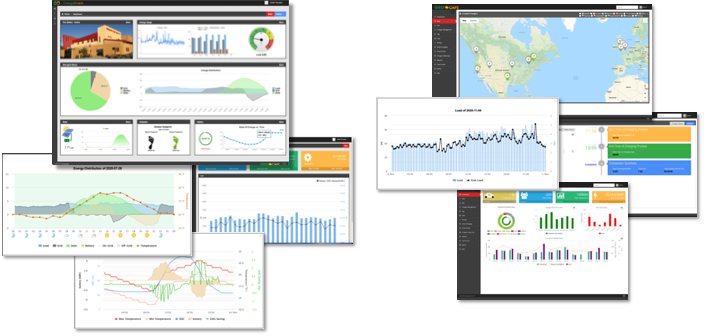Helping critical facilities stay online during emergencies.
Case study – Fontana Microgrid
Cities have to meet their climate action plan. They also need to make sure the critical facilities never go offline. Extreme weather conditions are leading to power outage disrupting the life of regular citizens but also affecting critical public services. A microgrid can keep the critical facilities running & help cities in cost savings since cities are always working under tight budgets.
Moving forward with local sustainable power plants (microgrids):
As part of the CEC grant funded project ( This is Gridscape’s second CEC grant)(EPC-17-052: Commercializing Virtual Wide Area Urban Microgrids for Grid .Resiliency and Disaster Readiness), a virtual wide-area urban microgrid (V-WAM) network will be deployed at five sites in Fontana (City Hall, Police Department, Senior Centre, Public Works, and Community Services).
About the California Energy Commission:
CEC is the state’s primary energy policy and planning agency. Created by the Legislature in 1974; its responsibilities include forecasting energy needs, promoting energy efficiency, supporting the renewable energy market etc. Within the last two years, the most important development in California’s energy policy has been two landmark pieces of legislation for energy policy that focus on climate change and transportation.

Why local sustainable power plants make sense for Fontana?
A large city like Fontana, which includes city hall, police headquarters, community centers, and PWD need to have power supply 24×7 to keep running since they are community resources. Critical facilities need electricity to function optimally; these facilities range from wastewater treatment plants, fire stations to hospitals, and more. A microgrid can offer the energy security these facilities need in a more sustainable manner
Additionally, cities have to meet their climate action plan, and utility. A microgrid can also help them in cost savings since cities are always working under tight budgets.
Benefits of a microgrid:
Microgrids can provide several benefits to the cities, critical facilities. These benefits are particularly important to cities, which strive to create safe, livable communities with thriving economies.
- Internal optimization via cost reduction, resource optimization, and resilience through islanding.
- During an emergency such as a wild fire, microgrid can help critical facilities to stay online and communicate with each other in a secure and reliable way.
- Microgrids can help cities need to accommodate the massive pressure coming from EV.
- Microgrids Provide Financial, Resilience, and Social Benefits
- Job generation and benefits
About Microgrid:
Microgrids are localized energy grids or a a self-contained power system that help facility owners take control back from the traditional grid, maintain a stable flow of power, and lock in utility rates.
One or more types of distributed energy (solar panels, wind turbines, cogeneration, generators) are used to generate electricity within microgrids. Furthermore, many new microgrids have energy accumulators, which are often batteries. Electric vehicle charging stations are also available.
Local, self-generation of power can be great for anyone who wants control over energy costs.

The Project
As part of the CEC grant funded project (EPC-17-052: Commercializing Virtual Wide Area Urban Microgrids for Grid Resiliency and Disaster Readiness), a virtual wide-area urban microgrid (V-WAM) network will be deployed at five sites in Fontana (City Hall, Police Department, Senior Centre, Public Works, and Community Services) to demonstrate how each of the following key aspects is improved through an innovative approach:
- Standardized microgrid configurations;
- Adaptable business case; and
- Virtual wide-area urban microgrid. The total microgrid size is of 1550 kWh that will save energy cost and GHG emission as well as provide resilience to the facilities.
As of now, the City has approved the design for the three sites and remaining sites are in the approval process.
- The project will save approx. $194,501 in energy costs annually.
- The project will also offset 981 MT of GHG annually.
- The project will reduce the peak demand and will contribute to additional cost savings.
Design
The project will be based on following figure system integration architecture for Gridscape projects with minor modifications/ alterations.

Typical System Integration Architecture
About Gridscape:
Gridscape is the largest and a well-established name specializing in developing and deploying standards-compliant future-proof products and solutions for renewable energy microgrids and fleet charging. Intended to serve as a locally produced sustainable power plant, these microgrids allow sites to become less reliant on the grid by using local sources of energy. They can provide as much as 90% independence from the grid energy, and thus reduce overall energy cost & provide backup clean emergency power during PSPS or other power disruption events. Gridscape with its ‘Product Centric’ approach to microgrids integrated with fleet EV charging solutions allows for lower cost of installation and reduces the time for deployment by substantially lowering integration issues. It expects to deploy and operate over 35 microgrids in California public and commercial facilities over the next 12 months. The list of Gridscape’s microgrid and EV charging customers and partners is as follows:
Unlike traditional microgrid developers, Gridscape employs a holistic product-centric, artificial intelligence (AI) based software-driven approach to designing, deploying, and managing microgrids. It also integrates Electric Vehicle (EV) charging and other controllable loads into its solution. Through its broad partnerships with various Tier 1 and Tier 2 financiers, design engineering firms, energy storage manufacturers and other renewable energy product providers, it leverages the best-in-class mix of technology and finance to provide maximum return on investment to customers.
Gridscape’s solution is unique, and it differentiates from traditional systems in following manner.
Product Centric Approach (vs Project Centric Methodology) for scalability, maintainability, and longevity of microgrid assets
Software driven architecture resulting into no technology obsolescence and ability to adapt to changing PG&E tariffs and distribution grid conditions.
Dynamically configurable with an ability to change the microgrid operational modes on demand
Energy Information System: A cloud-based distributed energy resource management system (DERMS) that includes
1
Smart AI-based energy management and optimized load and generation dispatch; and
2
Very powerful visualization dashboard for accessing real time and historical data about PV, Storage and EV charging stations.
Inherently Integrated with EV charging infrastructure
Full Energy Management including demand charge reduction, TOU arbitrage, grid services.
Integration with various Cloud platforms such as Google, Amazon for grid services and load management.
Gridscape EnergyScopeTM Dashboards

